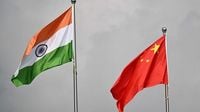After five years of grounded runways and diplomatic frost, India and China are poised to reconnect their skies. Starting October 26, 2025, direct flights between the two Asian giants will resume, marking a significant thaw in relations that had been frozen since the onset of the COVID-19 pandemic and the deadly border clashes of 2020. This development, widely reported by outlets such as TibetanReview.net, Reuters, and India Today, is being hailed as a milestone for both countries, signaling not just the restoration of travel but also a cautious step toward broader normalization of ties.
IndiGo, India’s largest low-cost carrier, will lead the charge by relaunching daily nonstop service between Kolkata and Guangzhou using Airbus A320neo aircraft. The first flight is set to take off on October 26, with plans for a New Delhi–Guangzhou route in the pipeline, pending regulatory approval. Pieter Elbers, CEO of IndiGo, expressed pride in the airline’s pioneering move: “We are proud to be amongst the first to resume direct connectivity to China from two points in India. This will once again allow seamless movement of people, goods, and ideas, while also strengthening bilateral ties between the two of the world’s most populous countries and fast-growing economies,” he told Routes Online.
The return of direct air links comes after years of diplomatic and operational limbo. Flights between India and China were abruptly halted in early February 2020, as the pandemic swept across borders and the world locked down. Complicating matters further, a deadly clash in the Galwan Valley that June left 20 Indian and four Chinese soldiers dead, plunging relations to new lows and ensuring that the airspace between the two neighbors remained closed. According to ET Now, India’s Ministry of External Affairs (MEA) spokesperson Randhir Jaiswal confirmed, “Commercial activity with respect to flight resumption has begun,” underscoring that the move is a product of intense technical and diplomatic engagement.
Before the pandemic, the skies between India and China were bustling. In 2019, nine nonstop routes connected the two countries, with more than 1.25 million two-way passengers shuttling between major cities such as New Delhi, Mumbai, Shanghai, and Guangzhou, according to Sabre Market Intelligence. Chinese carriers dominated the scene, with China Southern Airlines holding a 31% capacity share, China Eastern 27%, and Air China 17%. Indian airlines—including Air India and IndiGo—accounted for less than 20% combined. The largest city pair then was New Delhi–Shanghai, carrying about 149,000 passengers annually.
But by 2024, the landscape had changed dramatically. With direct flights suspended, passenger traffic plummeted by half to around 617,000, as most travelers were forced to take circuitous one-stop routes via hubs like Hong Kong, Singapore, and Bangkok. Mumbai–Shanghai emerged as the busiest city pair, but with just 60,000 passengers—a stark reminder of how far the market had contracted.
The new agreement, announced by the MEA on October 2 and reported by TibetanReview.net, follows months of technical-level talks between the civil aviation authorities of both countries. The MEA statement noted, “Since earlier this year, as part of the Government’s approach towards gradual normalisation of relations between India and China, the civil aviation authorities of the two countries have been engaged in technical-level discussions on resuming direct air services between the two countries and on a revised Air Services Agreement.”
As of early October 2025, five Chinese carriers have applied to India’s Directorate General of Civil Aviation (DGCA) for permission to operate passenger and cargo flights. These include China Eastern (which has been cleared for five weekly Shanghai–Delhi flights), Air China, and Shandong Airlines for passenger services, as well as China Southern and Sichuan Airlines for cargo operations. On the Indian side, Air India is preparing to resume direct flights to Shanghai before the end of the year, while Akasa Air has also signaled its intent to enter the China market. The current bilateral air services agreement allows each side access to six destinations and a maximum of 42 flights per week.
Notably, the resumption of flights is taking place even as both sides continue to negotiate a modernization of the air services agreement. A senior government official, speaking to The Hindu, explained, “We remain engaged on air service agreements,” but emphasized that ongoing talks would not delay the resumption of flights. The official added that the government’s priority was to restore connectivity and gradually normalize exchanges, rather than let technicalities stall progress.
The backdrop to this aviation detente is a broader, if cautious, warming of ties. Beginning in late 2024, India and China undertook a series of confidence-building measures, including disengagement along the Line of Actual Control (LAC) at Depsang and Demchok, high-level diplomatic and military dialogues, and the easing of trade restrictions on select goods. Prime Minister Narendra Modi’s visit to China in August 2025—his first in over seven years—was widely seen as a turning point, reflecting a mutual desire to stabilize the relationship and rebuild confidence.
Analysts, as cited by PTI and chinadaily.com.cn, view the resumption of direct flights as emblematic of these incremental efforts. The move is expected to boost economic activity, facilitate people-to-people exchanges, and restore some of the vibrancy that characterized pre-pandemic ties. The Indian Foreign Ministry echoed this sentiment, stating that the flights will “further facilitate people-to-people contact” and contribute towards the “gradual normalization of bilateral exchanges.”
Of course, it’s not just about symbolism. For businesses, students, and families on both sides, the return of direct flights will mean shorter travel times, reduced costs, and a renewed sense of connection. For the aviation sector, it’s a chance to reclaim lost ground and tap into the pent-up demand of one of Asia’s largest unserved markets.
Looking ahead, both governments appear committed to building on this momentum. As Pieter Elbers of IndiGo put it, “With this very important step, we are looking at introducing more direct flights into China. As we take steady strides towards becoming a global aviation player, this is a significant move to strengthen our international network.”
While challenges remain—especially regarding border issues and the nitty-gritty of aviation agreements—the reopening of skies between India and China is a tangible sign that, even after years of turbulence, the path to normalization is once again open.


